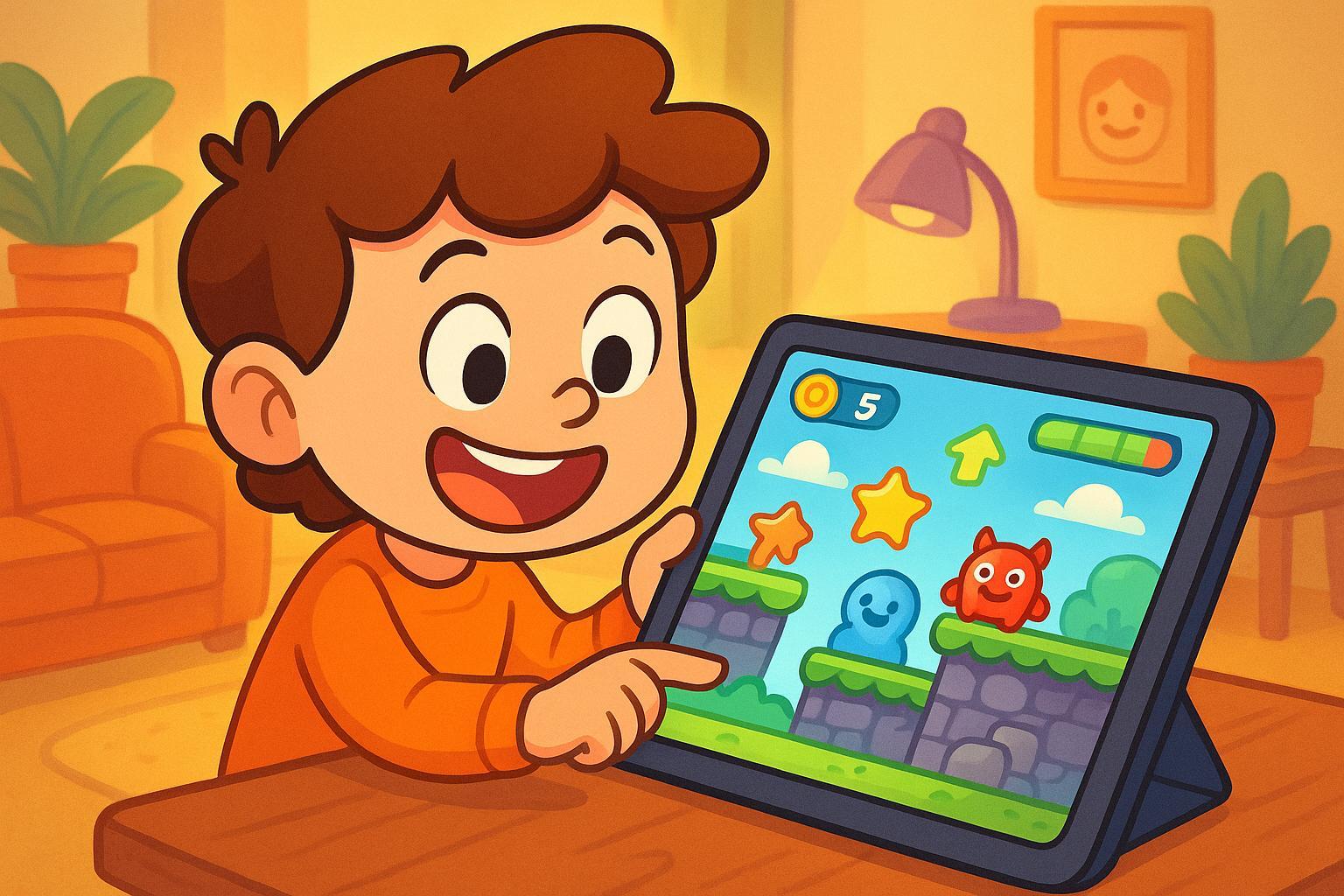
LongStories is constantly evolving as it finds its product-market fit. Features, pricing, and offerings are continuously being refined and updated. The information in this blog post reflects our understanding at the time of writing. Please always check LongStories.ai for the latest information about our products, features, and pricing, or contact us directly for the most current details.
Benefits of Adaptive Difficulty in Kids' Games
Adaptive difficulty in kids' games adjusts challenges in real time to match a child's skill level, keeping them engaged and learning effectively. Unlike fixed difficulty settings, adaptive systems use AI to monitor performance and tailor tasks, ensuring the right balance between fun and challenge. Here’s why it matters:
- Personalized Learning: Games adapt to each child's strengths and weaknesses, helping them master concepts at their own pace.
- Improved Engagement: Kids stay motivated by avoiding boredom or frustration.
- Bridging Gaps: Adaptive systems identify and address learning gaps, offering targeted support.
- Faster Progress: Research shows students learn up to 3x faster with adaptive difficulty compared to traditional methods.
This approach not only makes learning enjoyable but also ensures fair outcomes for all learners.
🎮 Creating Adaptive Difficulty! : Machine Learning in Game Development #gaming #gamedev #ai
Common Problems in Children's Educational Games
Educational games for children often stumble due to outdated designs that fail to cater to the unique ways kids learn. Since every child progresses at their own pace, these games frequently fall short in addressing diverse needs. The most common issues include rigid difficulty settings, lack of motivation, and failure to close learning gaps.
One-Size-Fits-All Problems
A major flaw in many educational games is their reliance on fixed difficulty levels. Instead of adjusting to the learner's abilities, these games stick to a single level of challenge. This approach alienates both advanced learners, who find the content too easy, and those who struggle, who may feel overwhelmed.
The consequences are clear. Studies reveal that games with unchanging difficulty can lead to boredom for some students and frustration for others, directly impacting their ability to learn effectively. This is particularly problematic given the wide range of learning styles, an area where game-based learning could thrive if properly designed.
Interestingly, research shows that while easier games tend to hold kids' attention longer - even when their failure rate is low - games with increasing difficulty often reduce motivation. This creates a tough balancing act for educators and designers: keeping kids engaged while also challenging them appropriately.
Low Motivation and Interest
When games fail to meet individual needs, children's motivation drops significantly. Research has shown that kids are most motivated when they can choose their own difficulty level. However, when difficulty is assigned without their input, they gravitate toward the easiest options. This underlines how traditional games often strip children of control over their learning experience.
Stanislav Stankovic, Senior Game Design Director at EA, puts it this way:
"If you are making a learning game, you are making something that will need to address the needs of two distinctly different groups of people - the children and their parents."
This dual audience creates a unique challenge for game developers, who must balance educational value with entertainment. If children aren't engaged, parents and teachers may lose trust in the platform, leading to lower usage. While well-designed educational games can boost engagement and even improve academic success, many fail due to poor design, lack of usability, and failure to align with educational goals. Without these critical elements, learning gaps persist and motivation wanes.
Skill Gaps and Missed Learning
Fixed-difficulty games often leave gaps in learning. When games move at a predetermined pace, they risk leaving some children behind while rushing past concepts others have already mastered. Without the ability to adapt, these games fail to address individual struggles, leaving foundational skills underdeveloped.
For instance, research shows that game-based learning can improve understanding by 11%. However, this benefit is lost when games can't adapt to the specific needs of each child. Adaptive systems are crucial for identifying and addressing personal challenges, but many games lack this capability.
Amey Laud, Founder of Hiperware, highlights the core issue:
"Most educational games start from a failed premise, assuming they can traverse the gap between education and entertainment."
This gap widens further when games fail to provide targeted support for children struggling with specific concepts. Instead of offering personalized help, these games enforce a uniform progression, creating knowledge gaps that only grow over time.
Another hurdle is the limited investment in educational games. As Laud explains, "there isn't much of a profit to be had, so few development resources are devoted to them". This lack of funding hampers the creation of advanced systems capable of meeting individual learning needs.
Despite these challenges, 74% of teachers have incorporated digital game-based learning into their classrooms. This shows a strong demand for solutions that go beyond one-size-fits-all models, focusing instead on tools that adapt to each child's unique learning journey.
How Adaptive Difficulty Fixes These Problems
Adaptive difficulty adjusts challenges on the fly, helping kids stay in a productive "flow state" as they learn. Unlike traditional games with static difficulty levels, this approach monitors a player's performance and tweaks the challenge in real time. The result? Learners stay engaged and absorb material more naturally.
Tailored Learning for Every Child
By leveraging statistical models, adaptive systems assess a child’s skill level and fine-tune content, pacing, and game mechanics to match their needs. This personalized approach can accelerate progress by up to three times. For example, studies like the "Alien Game" demonstrate how these systems simplify tasks for younger learners while ramping up complexity for advanced players. Similarly, EndeavorRx adjusts difficulty until the player achieves 80% accuracy.
Boosting Confidence and Engagement
Matching tasks to a child's ability level builds confidence, ensuring they experience frequent success. This sense of achievement fuels motivation - 67% of students report feeling more engaged in gamified learning environments. Immediate feedback and rewards further enhance this effect. As Diana Hughes from Age of Learning explains:
"For durable learning to happen, students have to make the decision that they want to know what we want to teach them."
Bridging Learning Gaps
Adaptive difficulty zeroes in on areas where students struggle, offering targeted exercises and hints until they master the material. Research supports this approach: AI-driven adaptive feedback improves conceptual understanding by 28%, boosts engagement by 35%, and reduces cognitive overload by 22%. This is especially important as many K–12 students face gaps in key subjects. Games like "Shapey Boats" exemplify this method by providing constructive feedback without penalizing mistakes. These precise adjustments not only address learning gaps but also enhance retention by up to 40%.
This dynamic system sets the stage for exploring the broader benefits of adaptive difficulty in educational games.
sbb-itb-94859ad
Main Benefits of Adaptive Difficulty in Educational Games
Adaptive difficulty in educational games offers much more than just a refined gaming experience. By tailoring challenges to match each child's abilities, these systems create personalized learning environments that help kids grasp concepts more effectively, stay motivated, and build critical skills. Let’s dive into how these mechanisms directly enhance learning outcomes.
Faster Learning Progress
Adaptive difficulty fine-tunes the learning process by keeping students in their optimal learning zone. Instead of overwhelming learners with tasks that are too difficult or boring them with overly simple ones, these systems adjust challenges in real time based on performance. For instance, a 2013 study from La Trobe University revealed that students using an adaptive game achieved better learning results compared to those using fixed-difficulty games or traditional written exercises. This improvement stems from the system’s ability to deliver personalized tasks that evolve as the learner progresses.
This approach ensures students have enough time to master foundational concepts before moving on to more complex material. The result? A faster, more efficient learning process that keeps students engaged and on track.
Higher Engagement and Fun
When challenges are just right - not too easy, not too hard - students are more likely to stay motivated and enjoy the experience. Adaptive systems excel at maintaining this delicate balance by continuously monitoring performance and fine-tuning the difficulty to keep learners in a state of flow. This "flow" is that sweet spot where tasks feel rewarding and achievable, fostering both enjoyment and persistence.
This positive cycle encourages students to associate learning with fun and self-confidence. For example, children often develop an appreciation for math when they see progress through engaging and well-calibrated challenges. Immediate feedback and rewards further amplify this effect, creating a loop of achievement and motivation that drives continuous learning.
Fair Learning Outcomes for All
One of the standout advantages of adaptive systems is their ability to cater to learners of all abilities and styles. Traditional teaching methods often leave some students behind while others lose interest due to lack of challenge. Adaptive difficulty eliminates this problem by tailoring the learning experience to meet each student’s unique needs.
Research shows that adaptive systems are particularly beneficial for students who might struggle in conventional classrooms, helping to bridge skill gaps and promote educational equity. For younger learners, content can be simplified, while more advanced students can tackle increasingly complex tasks. This ensures that every child progresses at a pace that suits them, building confidence and mastery along the way.
Additionally, because these adjustments are based on real-time performance rather than subjective judgment, adaptive systems remove human bias. They provide a consistent, fair learning experience for all students, relying solely on demonstrated ability to adjust the difficulty. This objectivity ensures that every learner gets a fair shot at success, regardless of their starting point.
How LongStories.ai Uses Adaptive Difficulty

LongStories.ai takes storytelling to a whole new level by using AI-driven adaptive difficulty. With just a single text prompt, the platform crafts over 5,000 personalized HD video stories, turning children into the stars of their own animated adventures. These fully voiced, interactive tales are more than just entertainment - they're designed to meet each child's unique learning needs.
Personalized, Interactive Stories
At its core, LongStories.ai prioritizes personalization. Every story evolves based on the child's learning journey, adjusting elements like vocabulary, narrative depth, and challenge levels to keep them engaged.
The platform’s AI Tellers are like digital mentors, each specializing in different subjects. They adapt their teaching styles depending on how the child interacts with the story. For example, if a child shows an interest in science, the AI might gradually introduce more advanced scientific ideas. On the other hand, if a child struggles with certain words or concepts, the AI simplifies explanations and adds helpful context. This approach turns passive screen time into a dynamic learning experience, where kids explore topics like history, science, and essential life skills through adventures that match their interests and abilities.
Real-Time Progress Tracking
LongStories.ai doesn’t stop at storytelling - it’s constantly learning, too. The system monitors how children engage with the stories, tracking indicators like comprehension and focus. This real-time feedback allows the AI to tweak story pacing and difficulty on the fly, ensuring each experience builds on previous successes while addressing any learning gaps.
Parents and teachers also benefit from this system. They receive detailed insights into the child’s learning patterns, making it easier to plan effective educational strategies. It’s like having a personalized progress report, but one that’s fun and engaging for the child.
Making Learning Fun and Easy to Access
One of the standout features of LongStories.ai is how effortlessly it creates high-quality content. In under a minute, it can generate a fully animated episode from a single text prompt. This means families can access adaptive educational content without needing any technical skills.
By combining storytelling, animation, and adaptive learning, the platform ensures that kids stay engaged, no matter their starting skill level or preferred learning style. Research even backs this up - studies suggest that AI-powered educational tools could reduce the academic achievement gap between high- and low-performing students by up to 20%. LongStories.ai plays a role in this by making personalized learning accessible to all families, regardless of budget or tech know-how.
Parents can also rest easy knowing the content is safe and age-appropriate. By blending adaptive difficulty with interactive storytelling, LongStories.ai transforms screen time into meaningful learning moments, proving that education can be both fun and effective.
Conclusion: How Adaptive Difficulty Changes Children's Learning
Adaptive difficulty takes educational entertainment to the next level by tailoring learning experiences to each child's abilities, helping them progress up to three times faster.
When challenges match a child’s skill level, it boosts their confidence. As Funexpectedapps.com puts it:
"The child connects fun and self-confidence to math learning. This experience at an early age will make them love math for life."
The impact is backed by real-world results. At a secondary school in Manchester, over 65% of students who previously struggled exceeded their targeted benchmarks after using adaptive software. Similarly, Arizona State University saw a 21% drop in dropout rates, paired with improved graduation rates over three years.
For students with learning differences, the potential is even greater. In Turkey, 82% of dyslexic students drop out before reaching university. Adaptive difficulty provides the customized support these learners need, giving them a better chance to succeed academically.
Platforms like LongStories.ai are making personalized learning more accessible. By creating custom animated adventures in under a minute, the platform removes barriers like high costs and technical hurdles. With over 5,000 video adventures already generated, LongStories.ai shows how education and entertainment can work hand in hand.
The key to this approach is understanding that every child learns differently. Adaptive difficulty doesn’t just improve grades - it nurtures lifelong learners who associate education with confidence and joy. As Colin Cooper, an expert in business growth and human behavior, explains:
"By recognising the unique needs of every learner, we can help students experience academic success and also develop a lifelong love of learning."
This move from standardized teaching to personalized learning is more than just a technological shift - it’s a promise to give every child the tools they need to reach their full potential.
FAQs
How does adaptive difficulty in games support children with different learning needs?
Adaptive difficulty in games tailors the challenge level to match a child's individual abilities, creating a learning experience that's both engaging and approachable. By customizing the gameplay, this method helps minimize frustration, keeps kids interested, and boosts their confidence as they achieve milestones.
This method is particularly helpful for children with learning differences. It ensures that tasks are neither too difficult nor too simple, striking the right balance to keep them engaged. This way, kids can grow and develop at a pace that suits them best.
What are some educational games that use adaptive difficulty to make learning more effective?
Adaptive difficulty in educational games adjusts the learning experience to match a child’s pace and abilities. Take games created for children with dyslexia, for instance - these games tweak challenges based on how the child performs, keeping the content engaging without becoming overwhelming. Similarly, platforms like My Math Academy customize lessons and assessments, helping kids progress at their own speed while making math feel more approachable and fun.
By adapting to individual needs, these tools not only make learning more effective but also help children build confidence and sharpen their skills along the way.
How can parents and teachers monitor a child's progress in games with adaptive difficulty?
Parents and teachers have access to built-in tools in adaptive difficulty games that make it easier to track a child's progress. These tools typically offer insights into areas like completed levels, skills mastered, and challenges the child may be struggling with.
This data gives educators and parents a better picture of how the game aligns with the child’s learning needs. With this information, they can provide specific support or encouragement to help the child succeed.
